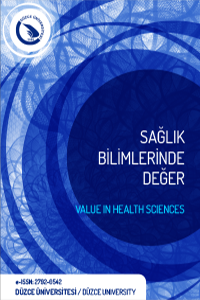Kadın Hastalıkları ve Doğum Hekimlerinin HIV (+) Gebe Yönetimindeki Bilgi, Tutum ve Davranışlarının İncelenmesi
Gebelik, fetal takip, HIV antikorları, bilgi, tutum, tıbbi uygulama yönetimi
Management of HIV Infection during Pregnancy by Gynecologist and Obstetricians
Pregnancy, fetal monitoring, HIV antibodies, knowledge, attitude, medical practice management,
___
- 1. Jaffar S, Grant AD, Whitworth J, Smith PG, Whittle H. The natural history of HIV–1 and HIV–2 infections in adults in Africa: a literature review. Bull World Health Organ. 2004; 82(6): 462-9.
- 2. Marlink R, Kanki P, Thior I, Travers K, Eisen G, Siby T et al. Reduced rate of disease development after HIV-2 infection as compared to HIV-1. Science. 1994; 265(5178): 1587-90.
- 3. Who.int [internet]. HIV/AIDS Data and Statistics [Cited: 25.11.2019]. Available from: https://www.who.int/hiv/data/en/ .
- 4. Kenyon C. Colebunders R. Voeten H. Lurie M. Peak HIV prevalence: a useful outcome variable for ecological studies. Int J Infect Dis. 2013; 17(5): e286-8.
- 5. Unaids.org [internet]. Children and HIV Fact sheet [Cited: 25.11.2019]. Available from: https://www.unaids.org/sites/default/files/media_asset/FactSheet_Children_en.pdf.
- 6. Unaids.org [internet]. UNAIDS 2017 [Cited:25.11.2019]. Available from: https://www.unaids.org/sites/default/files/media_asset/20170720_Data_book_2017_en.pdf.
- 7. Haas AD, Msukwa MT, Egger M, Tenthani L, Tweya H, Jahn A, et al. Adherence to antiretroviral therapy during and after pregnancy: cohort study on women receiving care in Malawi's option B+ program. Clin Infect Dis. 2016; 63(9): 1227-35.
- 8. Platten M, Pham HN, Nguyen HV, Nguyen NT, Le GM. Knowledge of HIV and factors associated with attitudes towards HIV among final-year medical students at Hanoi medical university in Vietnam. BMC Public Health. 2014; 14: 265.
- 9. Hsgm.saglık.gov.tr [internet]. Türkiye HIV/AIDS Kontrol Programı [Erişim tarihi: 29.11.2019]. Erişim adresi: https://hsgm.saglik.gov.tr/tr/bulasici-hastaliklar/hiv-aids/hiv-aids-liste/hiv-aids-tani-tedavi-rehberi.html.
- 10. Branson BM, Handsfield HH, Lampe MA, Janssen RS, Taylor AW, Lyss SB, et al. Revised recommendations for HIV testing of adults, adolescents and pregnant women in health-care settings. Centers for Disease Control and Prevention (CDC). MMWR Recomm Rep. 2006; 55(14): 1-17.
- 11. Gray AD, Carlson R, Morgan M, Hawks D, Schulkin J. Obstetrician-gynecologists’ knowledge and practice regarding human immunodeficiency virus screening. Obstet Gynecol. 2007; 110(5): 1019-26.
- 12. McKinney MM, McSpirit S, Pomeroy C. Prenatal HIV prevention practices in a low seroprevalence state. AIDS Educ Prev. 2000; 12(3): 252-62.
- 13. Olges JR, Murphy BS, Caldwell GG. Thornton AC. Testing practices and knowledge of HIV among prenatal care providers in a low seroprevalence state. AIDS Patient Care STDS. 2007; 21(3): 187-94.
- 14. Quach L, Mayer K, McGarvey ST, Lurie MN, Do P. Knowledge, attitudes, and practices among physicians on HIV/AIDS in Quang Ninh, Vietnam. AIDS Patient Care STDS. 2005; 19(5): 335-46.
- 15. Who.int [internet]. Global guidance on criteria and processes for validation: Elimination of mother-to-child transmission of HIV and syphilis. 2nd edition [Cited: 29.11.2019]. Available from: https://www.who.int/reproductivehealth/publications/emtct-hiv-syphilis/en/.
- 16. Ioannidis JP, Abrams EJ, Ammann A, Bulterys M, Goedert JJ, Gray L, et al. Perinatal transmission of human immunodeficiency virus type 1 by pregnant women with RNA virus loads <1000 copies/mL. J Infect Dis. 2001; 183(4): 539-45.
- 17. Massiah E, Roach TC, Jacobs C, St John AM, Inniss V, Walcott J, et al. Stigma, discrimination, and HIV/AIDS knowledge among physicians in Barbados. Rev Panam Salud Publica. 2004; 16(6): 395-401.
- 18. Aidsinfo.nih.gov [internet]. Panel on antiretroviral therapy and medical management of HIV-Infected children. Guidelines for the use of antiretroviral agents in pediatric HIV infection. [Cited: 29.11.2019]. Available from: http://aidsinfo.nih.gov/contentfiles/lvguidelines/pediatricguidelines.pdf.
- 19. Centers for Disease Control and Prevention. Revised recommendations for HIV screening of pregnant women. MMWR Recomm Rep. 2001; 50(RR-19):63-85
- 20. Committee on obstetric practice; HIV expert work group. ACOG committee opinion No. 752: prenatal and perinatal human immunodeficiency virus testing. Obstet Gynecol. 2018; 132(3): e138-42.
- 21. ACOG committee opinion. Scheduled cesarean delivery and the prevention of vertical transmission of HIV infection. Committee on Obstetric Practice. American College of Obstetricians and Gynecologists. Int J Gynaecol Obstet. 1999; 66(3): 305-6.
- 22. Grimes RM, Courtney CC, Vindekilde J. A collaborative program between a school of public health and a local health department to increase HIV testing of pregnant women. Public Health Rep. 2001; 116(6): 585-9.
- 23. Burr CK, Storm DS, Gross E. A faculty trainer model: increasing knowledge and changing practice to improve perinatal HIV prevention and care. AIDS Patient Care STDs. 2006; 20(3): 183-92.
- Yayın Aralığı: Yılda 3 Sayı
- Başlangıç: 2022
- Yayıncı: Düzce Üniversitesi
Düzce İlinde Son Bir Yılda Görülen Yurtdışı Kaynaklı Dört Sıtma Olgusu
Banu KESKİN, Bekir TUNCA, Nevin İNCE, Cihadiye ÖZTÜRK, Özlem GÖKÇE, Betül DÖNMEZ
Krill Yağı ve Sağlık Faydaları
Burçin ÖZÜPEK, Didem DELİORMAN ORHAN
Mustafa ALTINDİŞ, Hilal USLU YUVACI, Hande TOPTAN, Tuğba KAYA, Serhan CEVRİOĞLU, Oğuz KARABAY
İki Farklı Fakültede Öğrenim Gören Öğrencilerin Empati Düzeyleri
Şengül CANGÜR, Aylin ATEŞ, Beyza DİNDAR, Buse GÖKSU, Büşra ÇÜRÜKOĞLU, Döne HAN, Hilal ADANUR, Nesrin ELMAS
Ortopedi Hastalarının Venöz Tromboemboli Riskine İlişkin Bilgi ve Uygulamaları
Mevsimsel Alerjik Konjonktivitli Çocuklarda Sistemik İnflamasyon Biyobelirteçlerinin İncelenmesi
Biyoaktif Besin Peptitleri ve Sağlık Üzerine Etkileri
Ece YALÇIN, Neslişah RAKICIOĞLU
Sağlık Bilimleri Fakültesi Öğrencilerinin Toplumsal Cinsiyet Eşitliği Tutumlarının İncelenmesi
